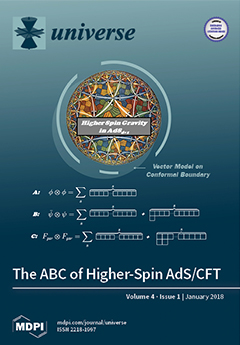In recent literature, one-loop tests of the higher-spin AdS
/CFT
correspondences were carried out. Here, we extend these results to a more general set of theories in
. First, we consider the Type B higher spin
[...] Read more.
In recent literature, one-loop tests of the higher-spin AdS
/CFT
correspondences were carried out. Here, we extend these results to a more general set of theories in
. First, we consider the Type B higher spin theories, which have been conjectured to be dual to CFTs consisting of the singlet sector of
N free fermion fields. In addition to the case of
N Dirac fermions, we carefully study the projections to Weyl, Majorana, symplectic and Majorana–Weyl fermions in the dimensions where they exist. Second, we explore theories involving elements of both Type A and Type B theories, which we call Type AB. Their spectrum includes fields of every half-integer spin, and they are expected to be related to the
singlet sector of the CFT of
N free complex/real scalar and fermionic fields. Finally, we explore the Type C theories, which have been conjectured to be dual to the CFTs of
p-form gauge fields, where
. In most cases, we find that the free energies at
either vanish or give contributions proportional to the free-energy of a single free field in the conjectured dual CFT. Interpreting these non-vanishing values as shifts of the bulk coupling constant
, we find the values
. Exceptions to this rule are the Type B and AB theories in odd
d; for them, we find a mismatch between the bulk and boundary free energies that has a simple structure, but does not follow from a simple shift of the bulk coupling constant.
Full article





